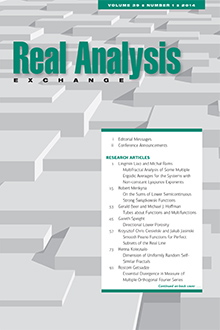Abstract
In this paper I examine products of a.e. continuous derivatives. Denote by \(\mathcal{N}_u\) the set of all \(x\) for which \(u (x) \neq 0\). First I prove that if \(u\) is a (bounded and/or non-negative) function with \(\mathcal{N}_u\) isolated, then \(u\) can be written as the product of two (bounded and/or non-negative) a.e. continuous derivatives. Next I show that if \(u\) is a.e. continuous and \(\mathcal{N}_u\) is a union of an isolated set and one with a null closure, then \(u\) can be written as the product of two a.e. continuous derivatives. I construct an example that we cannot require the factors be bounded in case \(u\) is bounded. Using this example I construct a bounded non-negative a.e. continuous function, \(v\), such that \(\mathcal{N}_v\) is the union of two isolated sets (so \(v\) is a Baire one star function and is the product of two bounded non-negative derivatives) and which cannot be written as the product of two a.e. continuous derivatives.
Citation
Aleksander Maliszewski. "On products of a.e. continuous derivatives." Real Anal. Exchange 21 (2) 548 - 554, 1995/1996.
Information





